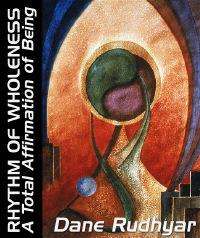 |
| Home | Bio | Art | Music | Literature | Civilization & Culture | Philosophy of Wholeness | Theosophy & Spirituality | Astrology |

RHYTHM OF WHOLENESS A Total Affirmation of Being by Dane Rudhyar, 1983 CONTENTS PROLOGUE PART ONE The Philosophy of Operative Wholeness 1. Prelude to a New Interpretation of Reality 2. The Search for Spiritual Security: The One, the Whole, and Wholeness 3. The Movement of Wholeness Page 1 Page 2 Page 3 Page 4 Page 5 PART TWO The Cycle of Being 4. The Structure of the Cycle of Being 5. The Four Crucial Phases of the Cycle of Being 6. The Inevitability of Success and Failure 7. Spirit and Mind PART THREE The Cycle of Man 8. Constitution of Man - The Physical and Psychic Bodies 9. Constitution of Man - The Spiritual Entity and the Higher Mind 10. The Structure and Transformation of the Total Person 11. The Cyclic Process of Spiritual Embodiment PART FOUR In The Spirit of Wholeness 12. The Principle of Holarchy and the Interplay of Horizontal and Vertical Relationships 13. Transpersonal Activity versus Mediumship 14. Rites of Passage EPILOGUE |

CHAPTER THREE
The Movement of Wholeness - 2 We begin with change because perpetual, unceasing change is the primary and most irrefutable experience of all human beings — of the writer, who is a human being conveying ideas born of his experiences to other human beings, and of his readers who, if they are intellectually honest, have to admit that nothing is more fundamental, more apparently incontrovertible, than the fact of perpetual, unceasing change. To exist means, first of all, to be part of a continuum of changes. The concept of Wholeness must be based on this fact. Therefore it must be a dynamic concept. Wholeness basically is experienced in terms of wholes of change — that is, in terms of cycles. The problem which logically arises is to understand how the consciousness of a nascent human being passes from the experience of an indefinite and undifferentiated continuum of changes to that of a whole of change. This implies the realization of how the cyclic or periodic nature of change develops. This development occurs because an infant's mind soon becomes aware that some particularly striking experiences emerge out of the continuous sequence of impacts upon his senses and internal organic feelings with a distinctness which is remembered, though at first memory is only of an organic and cellular kind. What is more, these distinct experiences are repeated. Repetition and the feeling of repetitiveness is the foundation of what gradually becomes a sense of ordered sequence — a sequence of "events" to which specific characters are given by the infant's mind, which also makes repetitive events into entities and names them. The process of naming definitely increases the feeling that these entities are permanent, at least insofar as they perform the same type of actions and the senses register them as having the same "form." Permanence, form, structural order in the process of change — and an increasing sense that various actions fulfill purposes — objectify and "set" the consciousness of unceasing change. For the developing consciousness, entities which maintain the same form become persons and objects to which the child reacts and relates in particular ways and with which he or she seeks to communicate. When the continuum of change is realized to be an ordered sequence of particularly distinctive and feeling-transforming events (the change from light to darkness, heat to cold, satisfaction to hunger, from a comfort-giving, pleasurable presence to solitude, and from noises to disquieting silence) the child sooner or later becomes aware that the sequence of events is rhythmic. He or she realizes that "periods" exist which are marked by important changes in the surroundings and in the behavior of people, and this realization gives rise to the sense of time. A series of changes occurs within a period beginning and ending with events which become markers of time. Much has been said about time which makes little sense, because the distinction and relationship between time, as human beings experience it, and the continuum of change is so often ignored. However, this distinction must be made if we are to understand the concept of cyclicity, wholes of time, and how time is affected by the structure of a greater whole to which a lesser whole belongs by virtue of its participation in the existence of the greater containing it. Time is the continuum of change as the consciousness of a particular person — and a collectivity of persons or a whole culture — experiences it in relation to a general or particular schedule of activities having to be performed. By the very fact of belonging to homo sapiens, a human being has a particular life span beginning with birth and ending with death. Therefore birth and death are the most significant markers of time for such a being, but many others also are established by the motions of the earth (days, months, years) and by definite biological, then social, and cultural transformations. Markers of time derive directly from the structure of any system of organization in which a person participates — as a member of the human species, a particular race, nation, social class, religion, family, even business firm or governmental bureau. Each greater whole imposes its special markers of time upon the individuals who belong to it because they play particular roles in it by performing regular series of actions. For example, in a family or factory a bell may ring to mark the start of the day, lunchtime, or periods of work; in medieval culture church bells and town criers regulated the activities of every member of towns or villages. These socio-cultural regulations follow the biological, diurnal, and seasonal markers of time which result from the motions of the earth. In other words, the manner in which a greater whole — cosmic, planetary, biological, or social — is structurally organized, and the number of actions and transformations which are expected of a person fulfilling a particular function in it between two successive markers of time, condition and often determine that person's sense of time. The person has "not enough time" to perform the actions (or interior transformations) required by the greater whole or by ambition to improve his situation in it — or conversely he or she has "a great deal of time." Thus the person perceives time as a commodity which is scarce or possessed in abundance. This commodity, time, depends on the relationship between a structural factor in a greater whole to which one belongs and the number of actions one wants or is expected to perform. Actually, when the greater whole is planetary or biological (and in ancient times when it was socio-cultural), the series of activities to be performed between two successive markers of time — for example, between sunrise and sunset, between one spring equinox and the next, and even more between birth and death — normally do not demand a feverish rush of activities (for which therefore it would be felt there was "so little time"). Thus human beings in the past felt time passing rather slowly. By contrast, in modern society, especially in business (though even in religious or spiritual spheres), where the drive to success, productivity, and profit (including "spiritual" achievements) has become abnormally intense and demanding, the individual never seems to have enough time. Mankind is driven at a feverish speed toward various kinds of successful (and dubious) achievements — and blames the pressure upon time. But the rhythm of planetary motion and the steady flow of the continuum of change has not accelerated. It is mankind which is rushing ahead, impelled by a philosophy of being — a Weltanschaaung and set of religious beliefs — which is essentially cathartic and out of tune with the rhythm of change. This disharmony exists because Western, Christian civilization has tragically opted for a world-picture featuring a straight-forward "historical progress" from barbarism to an ideal social and individual Utopia. Christianity violently rejected the concept of the cyclicity of change and of cycles of transformation and recurrence. It placed upon the period between physical birth and death an utterly unbearable burden of bio-psychic self-transformation — the neurosis-producing compulsion of being either saved or damned forever, that is, changelessly, absolutely. By permission of Leyla Rudhyar Hill Copyright © 1983 by Dane Rudhyar All Rights Reserved.  Web design and all data, text and graphics appearing on this site are protected by US and International Copyright and are not to be reproduced, distributed, circulated, offered for sale, or given away, in any form, by any means, electronic or conventional. See Notices for full copyright statement and conditions of use. Web design copyright © 2000-2004 by Michael R. Meyer. All Rights Reserved. |
 |